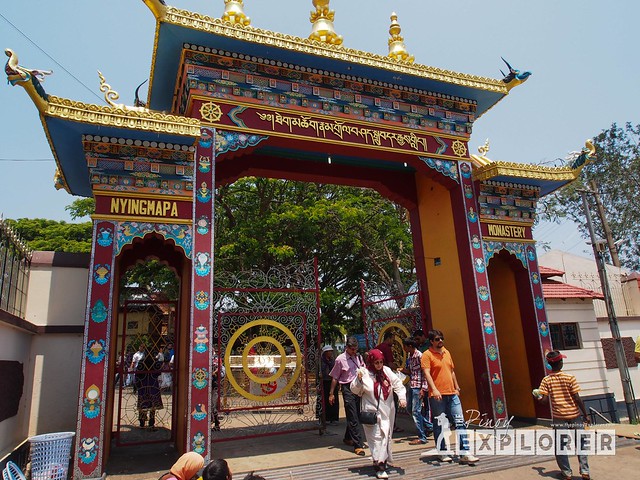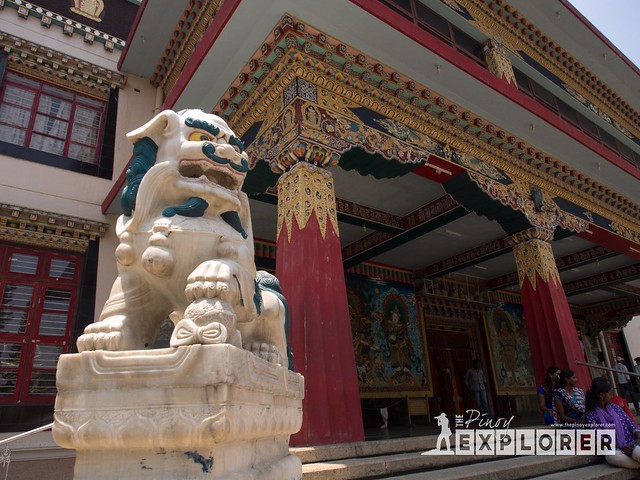Page was explored times
After Coorg, the long and winding downhill and the uphill road led us to a Tibetan settlement called Bailkoppa or Bylakuppe, which is known for its sandal groves. Bylakuppe Tibetan settlement consists of a number of small camps, monasteries, and nunneries and the most famous among them is the Namdroling Nyingmapa Monastery.
Tibetans took refuge in this settlement after China took over Tibet. In 1972, the refugees settled at Bylakuppe near Kushalnagar. It was also the time when Namdroling Nyingmapa Monastery or otherwise known as Namdroling Monastery and alternately called the Golden Monastery, was re-established in 1972 by His Holiness Pema Norbu Rinpoche. Later on, His Holiness the Dalai Lama consecrated the spot and bequeathed the name "Namdroling Monastery."
It is known to be the second largest Tibetan settlement outside Tibet. Home to over 7,000 monks, nuns and students Namdroling Monastery is the largest teaching center of the Nyingma lineage of Tibetan Buddhism in the world and is renowned as a center for the pure upholding of the teachings of the Buddha.
The monastery not only attracts a large number of young Tibetans seeking enlightenment and education but also draws tourists from all over India and abroad.
Getting inside the huge compound transports one to another world. Its sprawling grounds where silence is revered and preserved are themselves a place for quiet meditation. The temple is considered sacred thus, anyone who would go inside the Golden Temple would have to remove any footwear (socks are allowed), and needs to observe silence.



One cannot only admire the artistry inside but everyone is encouraged to some meditation or prayer or just sit idly and observe moments of silence.
The 40-foot tall golden Buddha statues are the major attractions of the monastery. The statues of Buddha (Center), Padmasambhava, and Amitayus dominate the altar, while the temple walls and columns are decorated with colorful paintings depicting gods and demons from Tibetan Buddhist mythology. The altar is adorned with fresh flowers, candles, and incense sticks.


For more photos, visit the Flicker site of The Pinoy Explorer.
Tweet
Do you like this article? Like us on Facebook, too!
After Coorg, the long and winding downhill and the uphill road led us to a Tibetan settlement called Bailkoppa or Bylakuppe, which is known for its sandal groves. Bylakuppe Tibetan settlement consists of a number of small camps, monasteries, and nunneries and the most famous among them is the Namdroling Nyingmapa Monastery.
Tibetans took refuge in this settlement after China took over Tibet. In 1972, the refugees settled at Bylakuppe near Kushalnagar. It was also the time when Namdroling Nyingmapa Monastery or otherwise known as Namdroling Monastery and alternately called the Golden Monastery, was re-established in 1972 by His Holiness Pema Norbu Rinpoche. Later on, His Holiness the Dalai Lama consecrated the spot and bequeathed the name "Namdroling Monastery."
It is known to be the second largest Tibetan settlement outside Tibet. Home to over 7,000 monks, nuns and students Namdroling Monastery is the largest teaching center of the Nyingma lineage of Tibetan Buddhism in the world and is renowned as a center for the pure upholding of the teachings of the Buddha.
 |
| Buddha Shakyamuni (Founder of Buddhism) |
 |
| Buddha Amiyatus (The Buddha of Long Life) |
 |
| Buddha Padmasambhava (Also known as Guru Rinpoche) |
The monastery not only attracts a large number of young Tibetans seeking enlightenment and education but also draws tourists from all over India and abroad.
Getting inside the huge compound transports one to another world. Its sprawling grounds where silence is revered and preserved are themselves a place for quiet meditation. The temple is considered sacred thus, anyone who would go inside the Golden Temple would have to remove any footwear (socks are allowed), and needs to observe silence.



One cannot only admire the artistry inside but everyone is encouraged to some meditation or prayer or just sit idly and observe moments of silence.
The 40-foot tall golden Buddha statues are the major attractions of the monastery. The statues of Buddha (Center), Padmasambhava, and Amitayus dominate the altar, while the temple walls and columns are decorated with colorful paintings depicting gods and demons from Tibetan Buddhist mythology. The altar is adorned with fresh flowers, candles, and incense sticks.


For more photos, visit the Flicker site of The Pinoy Explorer.
Tweet
Do you like this article? Like us on Facebook, too!
Thank you for reading The Pinoy Explorer! You can also like The Pinoy Explorer on Facebook! All contents of this blog, or otherwise stated, are copyrighted. For syndication, use of articles and photos, send me an e-mail. Thank you!



No comments :
Post a Comment